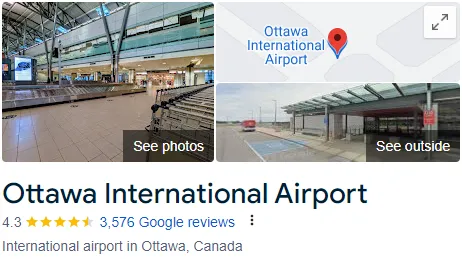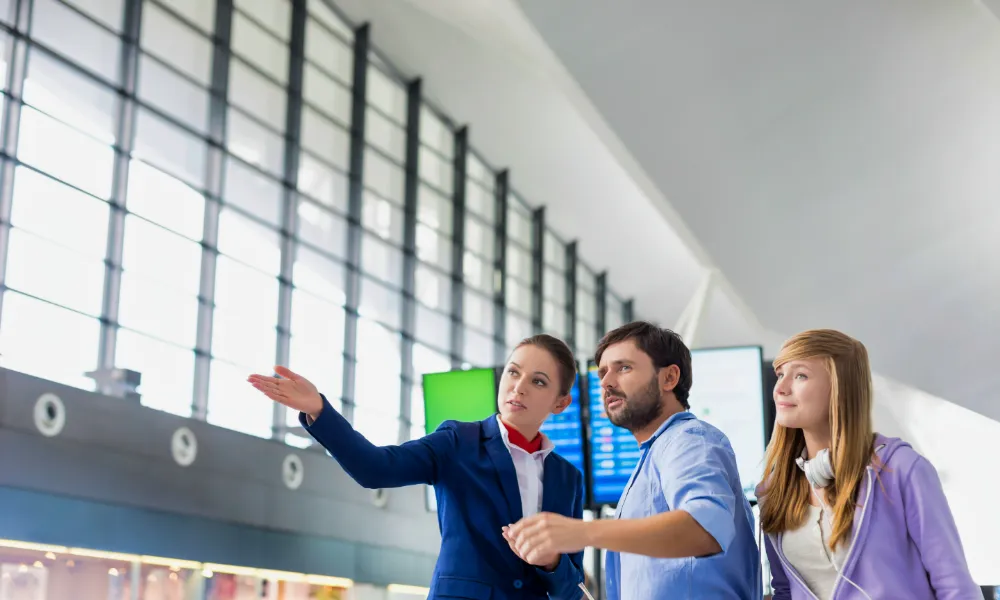
Ottawa Macdonald–cartier
International Airport
Assistance Services
Jodogo simplifies your Ottawa macdonald–cartier international airport experience by offering meet-and-greet services, lounge access, and a luxurious limousine for added comfort during your airport transfer. Below are the inclusions covered in our service offerings.
- Meet and Greet at Arrival Gate
- Meet and greet post-immigration
- Wheelchair Assistance
- Porter service
- Assistance at check-in
- Fast Track through immigration
- Priority boarding
- Assistance with baggage handling
- Expedited Service Through Security
- Assistance for terminal transfer
- Escort until car pickup
- Liaise with Driver
- Escort to lounge
- Escort until departure gate
- Buggy Transfer
- Expedited service through Immigration
- Meet and greet at curbside at car drop-off

Ottawa International Airport Assistance
International airport in Ottawa, Canada
Address: 1000 Airport Parkway Private, Ottawa, ON K1V 9B4, Canada
Ottawa/Macdonald–Cartier International Airport or Macdonald–Cartier International Airport (French: L'aéroport international Macdonald-Cartier) (IATA: YOW, ICAO: CYOW) is the main international airport serving Ottawa, Ontario, Canada, and its metropolitan area known as the National Capital Region. It is named after the Canadian statesmen and two of the "founding fathers of Canada", Sir John A. Macdonald and Sir George-Étienne Cartier. Located 5.5 nautical miles (10.2 km; 6.3 mi) south of downtown Ottawa in the south end of the city, it is Canada's eighth-busiest airport, Ontario's second-busiest airport by airline passenger traffic, with 2,992,334 passengers in 2022. The airport was the home base for First Air.
History Ottawa Macdonald–Cartier International Airport
On July 2, 1927, twelve P-1 airplanes under command of Major Thomas G. Lanphier, Air Corps, proceeded from Selfridge Field to Ottawa, acting as Special Escort for Colonel Charles Lindbergh, who was to attend at the opening of the Dominion Jubilee. First Lieutenant J. Thad Johnson, Air Corps, commanding 27th Pursuit Squadron, was killed in an unsuccessful parachute jump after a collision with another plane of formation in demonstration on arrival over Ottawa. There is now a street leading to the airport industrial section named after the aviator.
The airport was opened at Uplands on a high plateau (then) south of Ottawa by the Ottawa Flying Club, which still operates from the field. During World War II, when it was known as Uplands, the airport hosted No. 2 Service Flying Training School for the British Commonwealth Air Training Plan, providing advanced pilot training in Harvard and Yale aircraft.
In 1950, to allow for a southward expansion of the airport, the nearby farming community of Bowesville, settled from 1821, was expropriated. The last residents left and the village school was torn down in 1951. The current main airport terminal now stands on the site of the crossroads at the centre of the village. The road to the south of the airport still bears the name "Bowesville Road".
During the 1950s, while the airport was still named Uplands and a joint-use civilian/military field, it was the busiest airport in Canada by takeoffs and landings, reaching a peak of 307,079 aircraft movements in 1959, nearly double its current traffic. At the time, the airport had scheduled airline flights by Trans-Canada Air Lines (Toronto, Montreal, and Val-d'Or), Trans Air (Churchill), and Eastern Air Lines (New York via Syracuse and Washington via Montreal). With the arrival of civilian jet travel, the Canadian government built a new field south of the original one, with two much longer runways and a new terminal building designed to handle up to 900,000 passengers/year. The terminal building had been scheduled to open in 1959, but during the opening ceremonies, a United States Air Force F-104 Starfighter went supersonic during a low pass over the airport, and the resultant sonic boom shattered most of the glass in the airport (including the entire north wall) and damaged ceiling tiles, door and window frames, and even structural beams.As a result, the opening was delayed until April 1960. The original terminal building and Trans-Canada Airways/DOT hangar continued in private use on the airport's north field until the fall of 2011 when it was demolished.

Facility layout Ottawa Macdonald–Cartier International Airport
Diagram of the Ottawa airport (prior to 2005)
The airport consists of two distinct airfields connected by a taxiway. The smaller north field, originally referred to as Uplands, was founded by the Ottawa Flying Club in the late 1920s and then used by Trans-Canada Air Lines, the predecessor of Air Canada.
This was the area primarily used by No. 2 Service Flying Training School. Several hangars were constructed during World War II, but were all demolished by the early 2000s.
The north field is still popular for general aviation, although only one of its runways, 04/22, is still in use. There are a number of aircraft component repair facilities located within the same grouping of buildings as the Ottawa Flying Club.
The south field consists of the two longer runways, 07/25 and 14/32, designed for jet airliners. The public passenger terminal is tucked into the north side of the intersection of the two runways, while the two general aviation FBOs for the south field are nearer to the threshold of runway 25. Customs services for private aircraft are available at the two fixed-base operators (FBO), Shell Aerocentre and Skyservice Business Aviation, on the south field. There are also a number of aviation component repair facilities on the airport grounds, mostly around the Skyservice complex. The Government of Canada operates a number of hangars, including the Canada Reception Centre, which is used to greet visiting dignitaries. The National Research Council operates two facilities on the north side of the grounds, including two wind tunnels. One of these has supersonic capabilities, and the other has a 9-meter diameter, making it the largest in Canada. Transport Canada operates two facilities on airport grounds, one of which houses training equipment, including flight simulators, and the other is a hangar for maintenance and storage of government owned aircraft.

Interior design Ottawa Macdonald–Cartier International Airport
Terminal interior
The terminal's design focuses on creating a calm and easy travel experience for passengers but also honours aspects of the region through the display of various art by commissioned Canadian artists. A soothing water feature representing the meeting of the region's three rivers runs throughout the terminal. Copper and limestone finishes are visible throughout, representative of the capital's Parliament Buildings. Other Canadian features include an inukshuk commissioned and sponsored by
First Air, and a rare traditional birch bark canoe built by the master craftsman and Algonquin leader who created an identical one for the late Prime Minister Pierre Elliott Trudeau.The airport features a large-scale carved glass sculpture by Canadian glass artist, Warren Carther.
services at Ottawa Airport:
- Restaurants and cafeterias
- Shops and duty free
- Wi-Fi access
- Baggage storage
- ATMs
- Currency Exchange
At Ottawa Airport you can use the following transport options:
Bus: OC Transportation provides frequent bus transportation from and to Ottawa Airport.
Taxi: It is possible to get to Ottawa city centre in just 20 minutes by taxi.
Transfers: If you want private transportation to and from Ottawa, you can book a transfer.
Car rental: To rent a car in Ottawa is a great idea, find your best option with our search engine.

Why should you use JODOGO Airport Assistance?
- Avoid long lines and save time: JODOGO's Meet and Greet services help you bypass long queues at the airport, saving you valuable time and ensuring a seamless travel experience.
- Have a stress-free travel experience: JODOGO’s experienced and professional staff will handle every detail of your airport experience, allowing you to relax and enjoy your journey.
- Get personalized attention: JODOGO’s staff provides personalized attention and assistance, ensuring all your needs are met with care and efficiency.
- Enjoy a variety of services: JODOGO offers a variety of services to meet your needs, including Meet and Greet, porter assistance, fast-track check-in and security, and lounge access.
- Benefit from competitive rates: JODOGO offers competitive rates for its services, making it an affordable option for travelers. Enjoy 24/7 support—JODOGO is always available to assist you with your travel needs.
- Experience a smooth and efficient airport experience: JODOGO's staff is trained to deliver a smooth and efficient airport experience for every traveler.
- Feel confident and secure: JODOGO's knowledgeable and experienced staff ensures you are always in good hands.
- Relax and enjoy your trip: With JODOGO's assistance, you can relax and enjoy your journey, knowing your airport experience is fully taken care of.
FAQs for Airport Assistance
- Visit our website: Go to https://jodogoairportassist.com/airports/ottawa-macdonald-cartier-international-airport.
- Fill out the online form: Provide your flight details, arrival/departure information, and desired services.
- Select your preferred payment method: We accept major credit cards and PayPal.
- Confirm your booking: Upon confirmation, you'll receive an email with all the details.
Yes, we offer VIP concierge services at Ottawa International Airport to provide a luxurious and personalized experience. Enjoy dedicated assistance with everything from luggage handling and expedited procedures to luxury transportation and personalized airport lounge access.
Additional Services:
- Ottawa airport VIP Services
- Ottawa Airport Fast Track
- Ottawa Airport Special Assistance
- Ottawa Airport Private Transfers
- Ottawa Airport Personal Assistant
Please note: This FAQ content is intended to provide a general overview of our services at Ottawa Airport. Visit our website for the latest information and specific details regarding our services and pricing.
For more information visit our website: https://www.jodogoairportassist.com/services
Related Airports

Toronto Pearson International Airport, the largest and busiest airport in Canada, is the primary international gateway serving Toronto. Committed to providing an exceptional travel experience, it offers world-class facilities focused on ensuring the health, safety, and peace of mind of every passenger.

Montréal–Trudeau International Airport (IATA: YUL, ICAO: CYUL) (French: Aéroport International Montréal-Trudeau) or Montréal–Trudeau, formerly known and still commonly referred to as Montréal–Dorval International Airport (Aéroport international Montréal-Dorval), is an international airport in Dorval, Quebec, Canada. It is the only Transport Canada designated international airport serving Montreal and is situated 20 km (12 mi) west of Downtown Montreal. The airport terminals are located entirely in the suburb of Dorval, while one runway is located in the Montreal borough of Saint-Laurent. Air Canada, the country's flag carrier, also has its corporate headquarters complex on the Saint-Laurent side of the airport.

Halifax Stanfield International Airport (IATA: YHZ, ICAO: CYHZ) is a Canadian airport in Goffs, Nova Scotia, a rural community of the Halifax Regional Municipality. It serves the Halifax region, mainland Nova Scotia, and adjacent areas in the neighbouring Maritime provinces. The airport is named in honour of Robert Stanfield, the 17th Premier of Nova Scotia and former leader of the federal Progressive Conservative Party of Canada.



